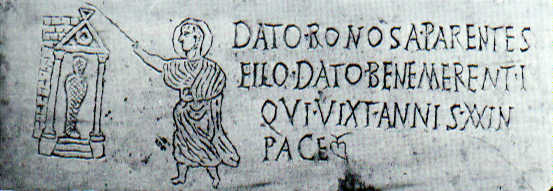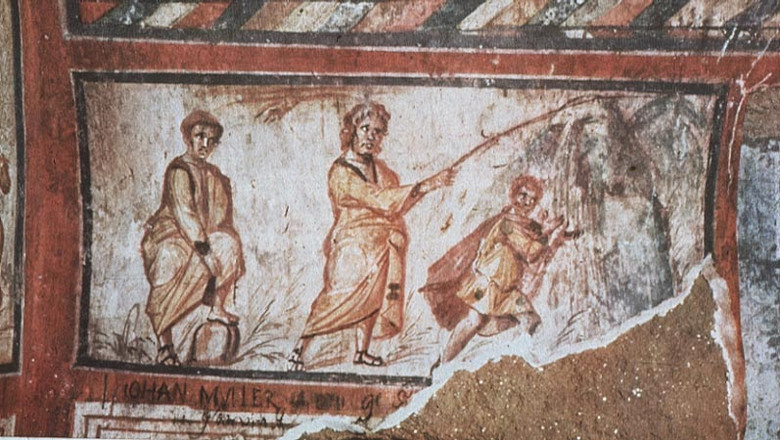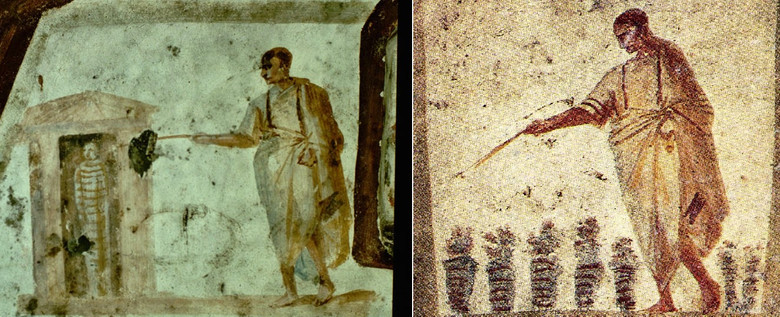This shell, at least, in that look as it was applied in Europe, is only one of links of the whole system of magic devices. His prototype, undoubtedly, existed in an extreme antiquity; however it is impossible to establish direct link between ancient ways of its application and a darkness which we meet in Europe at the end of the Middle Ages.
This image in itself is known since the most ancient times — archeologists have found ancient rock paintings on which the figures holding sticks are represented, and subsequently many Indo-European people represented the gods with various objects in hands (often similar to a stick) symbolizing their power and had legends on various magic staffs.
Priests of a number of the people used similarity of staffs for commission of various ceremonies. There are various hypotheses of an origin of this image — communication with a cult of a phallus or initial use as a drum stick by shamans.
There are several early images of Jesus Christ where he is shown with a certain stick in a hand. On the basis of it some consider that Jesus was a sorcerer.
Apparently, during all intermediate period the magic wand has been widespread in the people and methods of its application were exposed to various changes. What was her destiny at this time, we don’t know as medieval authors hold back it and we can report nothing about her history. Only the following is known.
At the Roman emperor Valente (364 — 379) many noblemen accused that they have allegedly made a plot against him and in the magic ways tried to learn a name of his successor. They used for this purpose the ring suspended on a thin thread; one of attendees held her over a round metal bowl at which edges through equal intervals letters have been engraved. The ring was set in rotary motion along edges of a bowl and on some letters it as if stumbled. According to these instructions the proper word was formed.
Since then similar devices aren’t mentioned anywhere to Paracelsus (the Swiss alchemist, the doctor, the philosopher, the scientist of 1493-1541) who in one of the compositions tells that the German miners use the twig having the form Y for search of the hidden ores.
Holding a shell for two ends in horizontal position, the seeker slowly moves across the field; the free end of a stick bends to the earth in that place where there is a metal.
Not everyone, however, is able to do it, and indications of a twig aren’t always authentic so Paracelsus ranks this reception as “incorrect means”. Possibly, this custom hasn’t been especially widespread because differently almost omniscient in magic, Agrippa for certain would mention him as such phenomenon very much suited to this to sympathy of things.
Paracelsus at the wanderings among the lowest classes has probably come across incidentally this way and, having described him in the compositions, promoted his wide circulation. In any case, the magic wand is mentioned by all subsequent authors; by the way, it is told about her in alchemical compositions of Vasily-Valentina (the monk-alchemist living in the 14th or 15th century).
Moisey with a stick in a hand. The drawing from the Roman catacombs of St. Callixtus
Views of a magic wand and its application were very different; some authors say that the twig has to be taken from the tree taking a natural liking for the found metal that is the special species of a tree is necessary for each metal.
Others claim that breed of a tree means nothing, and it is important that the twig was flexible so it is the best of all to take him from a willow, a hazel grove or an ash-tree. One explain all with natural sympathy, others — especially clergy — see in it intrigues of a devil, at last, the third call it just superstition.
In 1630 one French nobleman has made valuable discovery that willow and alder twigs can serve also for detection of underground water veins. The scientific world, however, till 1692 wasn’t interested in this phenomenon, but from this year the curious head in the history of a magic wand begins. On July 5, 1692 at ten o’clock evenings have been found by the killed in Lyon the wine merchant and his wife.
As the authorities haven’t found any traces of the murderer, at the initiative of the individual, the rich land owner, the peasant Jacques Aimar who was renowned for the ability by means of a magic wand to find not only metal and water-bearing veins, but also thieves and murderers has been invited. Aimar has told at once that the stick pulls him in three directions so murderers there have to be three.
He followed indications of a stick throughout several miles on the ground and on water and at last has found the person on who has pointed as to the murderer.
That denied the participation, but nevertheless has been executed as the court managed to gain from him some doubtful recognitions. Incident it has caused big nervousness; several scientific books which in different ways tried to explain such action of a stick have been written.
Ecclesiastics have seen in it intrigues of a devil, but the theologian Valdemont has spoken absolutely categorically in the composition “The secret force, or the treatise about a magic wand” that the phenomenon it is in a full consent with magnetic and electric actions and that therefore there is no basis to allow here intervention of supernatural forces.
He, as well as all other scientists, has absolutely forgotten about whether really the stick executed that demanded from it. A hard blow was received by all theory when it was revealed that the famous physicist Afanasy Kirkher has proved almost for half a century before that the twig doesn’t bend neither to water, nor to other subject if isn’t in hands of the person, and is attached for two ends so that can freely rotate.
Business has still worsened when Jacques Aimar has been called to the son of the duke Konde and different experiments have forced to do him. It has become clear that he couldn’t find either the waters, or metal hidden by people and wasn’t able to find the thieves already famous to police. Then only have begun to doubt whether really executed was убийцею.
At last, the priest Lebren has explained this question by many experiments with persons in which hands the stick came to the brisk movement. First of all he has assumed influence of a devil therefore hotly convinced those with whom conducted experiments, to ask God that the stick remained immovable if evil spirits are involved in business. After that the stick immediately became motionless.
It is surprising that the priest has absolutely unexpectedly made the most correct conclusion of such experiences, namely that “the reason of the movement of a stick lies in desires of the person and goes his intentions”.


